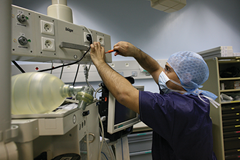Cost saving tips for healthcare and industry
 Are you a healthcare professional looking to reduce the running costs of your establishment? Or an industry expert facing cost and production constraints? This article explores the issues at stake for healthcare organisations and industries striving to achieve sustainable energy efficiency.
Are you a healthcare professional looking to reduce the running costs of your establishment? Or an industry expert facing cost and production constraints? This article explores the issues at stake for healthcare organisations and industries striving to achieve sustainable energy efficiency.
As emphasised at the last Institute of Healthcare Engineering and Estates Management (IHEEM) event in Newcastle, County Down, in May, healthcare facilities have long recognised the critical role that providing a comfortable environment plays, by maintaining appropriate levels of heating, cooling, lighting and air quality within buildings. At the same time, growing budgetary pressures and rising prices are putting a focus on reducing the cost of providing these services.
These cost and efficiency drivers necessitate the delivery of more energy services for less energy input, at a lower cost through investment in more efficient technology, more efficient operating practices, to ensure that sustained benefits are delivered.
The issue of ageing and inefficient energy infrastructure can, in parallel, be a serious concern to many establishments. A performance partnership with an energy services provider, whose core focus is energy efficiency and guaranteed saving reductions, can deliver these benefits. Partnership brings security of energy provision with cost, energy and carbon savings through overall efficiencies and improvements in the site’s running costs. To illustrate, the provision of lighting, heating and cooling, while critical, is non-core, and presents an opportunity to outsource delivery.
For success, organisations need the support of energy management professionals who understand that energy efficiency can only be achieved through a full energy cycle approach with delivery know-how. For any site to do this sustainably, its owners need firstly to take a long-term view of their business, their site and their relationship with the energy and utilities management company with whom they work, as the required contracts can last anywhere between 5 and 25 years.
Securing the supply of input energies such as biomass, natural gas, oil or electricity is the first and vital step in terms of comfort and care; however, it is not the end goal. These input energies need to be transformed (e.g. converting oil into heat, electricity into cooling etc.) into useable forms, distributed (for example hot water through piping networks) and then consumed at the point of customer need (radiators, light fittings etc.). Efficiencies and cost savings can be made by focusing on one of these steps. However, it is the integrated management, measurement, monitoring and targeting of the entire energy process in a co-ordinated, structured approach which delivers the maximum benefits to the establishment.
Utilities plants are also at the heart of most industrial companies. Without utilities, nothing gets produced.
Dalkia works to help companies to increase the reliability and availability of their utilities, while improving efficiencies and reducing energy used and carbon produced.
Contact us today:
Tony Doherty,
General Manager
at Dalkia Energy and Utilities Services, at 07879036270 or email infoni@dalkia.co.uk or info@dalkia.ie

![1. logo_dalkia_quad EPS [Converted] 1. logo_dalkia_quad EPS [Converted]](http://www.agendani.com/wp-content/uploads/dalkia_thumb.png)




